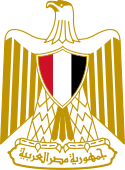- 2011 Provisional Constitution
-
For earlier constitutions of Egypt, see History of the Egyptian Constitution.
Egypt 
This article is part of the series:
Politics and government of
EgyptGovernmentLegislativeElectionsPolitical partiesForeign policy
The Provisional Constitution of the Arab Republic of Egypt or Constitutional Declaration of 2011 is the new provisional fundamental law of Egypt. It was adopted on March 30, 2011 by the Egyptian Supreme Council of the Armed Forces who have been in power since the former president Hosni Mubarak relinquished his powers to the Supreme Council of the Armed Forces on February 11, 2011.
The 63-article provisional constitution was proclaimed to operate as a working constitution in the current political transitional period following the revolution, until a new one is drafted and approved. The new provisional constitution have included the most recent amendments publicly approved in a referendum, provisional articles defining the powers of the executive and judicial branches as well as institute laws to govern the presidential and parliamentarian election processes.
It has paved the way for parliamentary elections in September and presidential elections in November. It directly stipulated that the newly elected parliament to form a new constitutional drafting committee to write a new constitution.
Contents
Overview
The constitution establishes Egypt as a "Democratic State", deriving its sovereignty from the people, and as part of the Arab World. It proclaims the system of government as a multi-party Semi-presidential system within the framework of the basic principles and components of the Egyptian society.
The Constitution establishes party plurality as the foundation of the political system (Article 1) and so allows the formation of different political parties, however political parties are not allowed to be established based on any discriminatory basis such as religion, race or sex (Article 4).
The declaration upholds that "Individual freedom is a natural right" and regards all citizens as equals. It guarantees a set of freedoms including: The "right to protect the private life of citizens"(Article 8), "Freedom of belief and the freedom of practising religious rights" (Article 12), "Freedom of expression" (Article 12), Freedom of Press and other publications (Article 13), Freedom of peaceful and unarmed private assembly, without the need for prior notice (Article 16), Universal suffrage, as well as the right to form civil societies (Article 4).
Delegations and Exercise of Sovereignty
Executive
The executive branch is made up of the President, the Prime Minister, the cabinet of ministers and the local administration. The President appoints the Prime Minister from the party winning the majority of seats in parliament. However the President has the power to relieve the Prime Minister from office without the parliament’s approval and may also remove the cabinet of ministers but after the consultations of the prime minister. The President serves for a four years term with a limit of two terms.
A candidate is eligible for office after meeting the following qualifications: The nominee must be an Egyptian citizen of at least 40 years of age, have never held another citizenship, and must not be married to a foreigner. Both of the nominee’s parents must be Egyptian citizens, and have never held foreign citizenship. The nominee must not be under a suspension of political and civic rights. (Article 26)
Article 27 defines the different tracks for nomination which candidates may choose in presidential elections: - Nominees must win the endorsement of 30 elected members of Parliament; - Nominees must win the endorsement of 30,000 registered voters from 15 governorates with at least 1000 endorsements from each of those governorates; - Parties with at least one elected seat in parliament may nominate one of their members in presidential elections.
Legislative
According to the constitution, the parliament is made up of two chambers: The People’s Assembly, the lower house and the Shura Council, the upper house. The parliament will assume its legislative powers from the military council after its elections in September 2011.
Judicial
According to the constitution, the Judiciary is an independent body and is vested with powers to oversee the practices of both the executive and legislative branches. Judges are independent and can not be taken out of office.
References
External links
- CNN "Egypt to announce new working constitution." March 2011.
- BBC "Egypt referendum strongly backs constitution changes" March 2011
- Arabic Text of the provisional constitution
- English Translation of the provisional Constitution
Constitution of Africa Sovereign
states- Algeria
- Angola
- Benin
- Botswana
- Burkina Faso
- Burundi
- Cameroon
- Cape Verde
- Central African Republic
- Chad
- Comoros
- Democratic Republic of the Congo
- Republic of the Congo
- Côte d'Ivoire (Ivory Coast)
- Djibouti
- Egypt
- Equatorial Guinea
- Eritrea
- Ethiopia
- Gabon
- The Gambia
- Ghana
- Guinea
- Guinea-Bissau
- Kenya
- Lesotho
- Liberia
- Libya
- Madagascar
- Malawi
- Mali
- Mauritania
- Mauritius
- Morocco
- Mozambique
- Namibia
- Niger
- Nigeria
- Rwanda
- São Tomé and Príncipe
- Senegal
- Seychelles
- Sierra Leone
- Somalia
- South Africa
- South Sudan
- Sudan
- Swaziland
- Tanzania
- Togo
- Tunisia
- Uganda
- Zambia
- Zimbabwe
States with limited
recognitionDependencies and
other territories- Canary Islands / Ceuta / Melilla / Plazas de soberanía (Spain)
- Madeira (Portugal)
- Mayotte / Réunion (France)
- Saint Helena / Ascension Island / Tristan da Cunha (United Kingdom)
- Western Sahara
States with limited
recognitionDependencies and
other territories- Christmas Island
- Cocos (Keeling) Islands
- Hong Kong
- Macau
Categories:- Politics of Egypt
- Constitutions of Egypt
- Provisional constitutions
Wikimedia Foundation. 2010.
